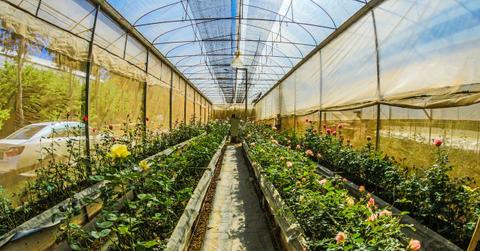Extra Heat Generated From Bitcoin Mining Fuels Local Greenhouse
The process of mining Bitcoin requires an extremely large amount of energy. At the same time, it generates a lot of heat, and a Canadian startup is finding helpful uses for it in raising fish and plants.
Updated May 23 2019, 10:07 a.m. ET
Cryptocurrencies such as Bitcoin have become mainstream as the value skyrocketed toward the end of 2017. One of the hidden storylines behind the phenomenon of the currency is the massive amount of energy it uses when mining it. Taking advantage of the heat generated from the process, a startup is able to grow plants and food that could add to the value of Bitcoin.
In December, Bitcoin reached its highest value of just over $19,000 US. It’s been incredibly unstable after that time, shooting rapidly up and down. There’s plenty of uncertainty for this decentralized currency, which many still see as a potential investment to make money, but what we do know is that it takes a lot of energy to create units of Bitcoin.
Even though the value of Bitcoin has been falling rapidly lately, which it’s done in the past three years around this time period, energy consumption continues to rise rapidly. According to Digiconomist, global energy usage has gone from just under 35 terawatt-hours in December 16th to just over a record-high of 42.1 terawatt-hours on January 16th.
That level of consumption is equivalent to energy use in all of Denmark or New Zealand, who both have around a population of five million people. With so much electricity being generated, this has created a rate of 20 million metric tons of carbon dioxide emissions, and that’s only going to grow as consumption rapidly jumps through January. After all, 80 percent of Bitcoin mining costs are from the electricity needed in the process.
In order to solve this massive waste, Bruce Hardy, a Canadian-based mining farmer, has created a way to use the heat that’s generated in this process for agriculture. It’s led to Hardy establishing a new startup, Myera Group, that focuses on the problem of energy consumption from technology to create a sustainable food source.
Hardy began this process two years ago, converting a 20,000 square foot building near Winnipeg into a Bitcoin mining farm with 30 computers. Instead of paying for air conditioning to keep things cool, he found a new way to use the heat. 800 cold-water fish are being raised on the first floor, and this water can be pushed up to the second floor to help grow plants, such as basil and lettuce.
Thanks to the sudden increase in Bitcoin value over time, Hardy has been able to upgrade his operations to showcase the potential of excess heat. This could lead to further investment into the currency and it may have the potential to stabilize it. The startup has seen interest from Australian researchers and Chinese investors, according to a CBC report.
Hardy is experimenting with other ways to take advantage of the heat from mining to expand the second floor of his building. There could also be more mining stations opening up in Manitoba, which these operations would benefit from with cold weather and cheap hydroelectricity rates. Hardy tells the CBC that they could “do all sorts of great things” with that potential.
